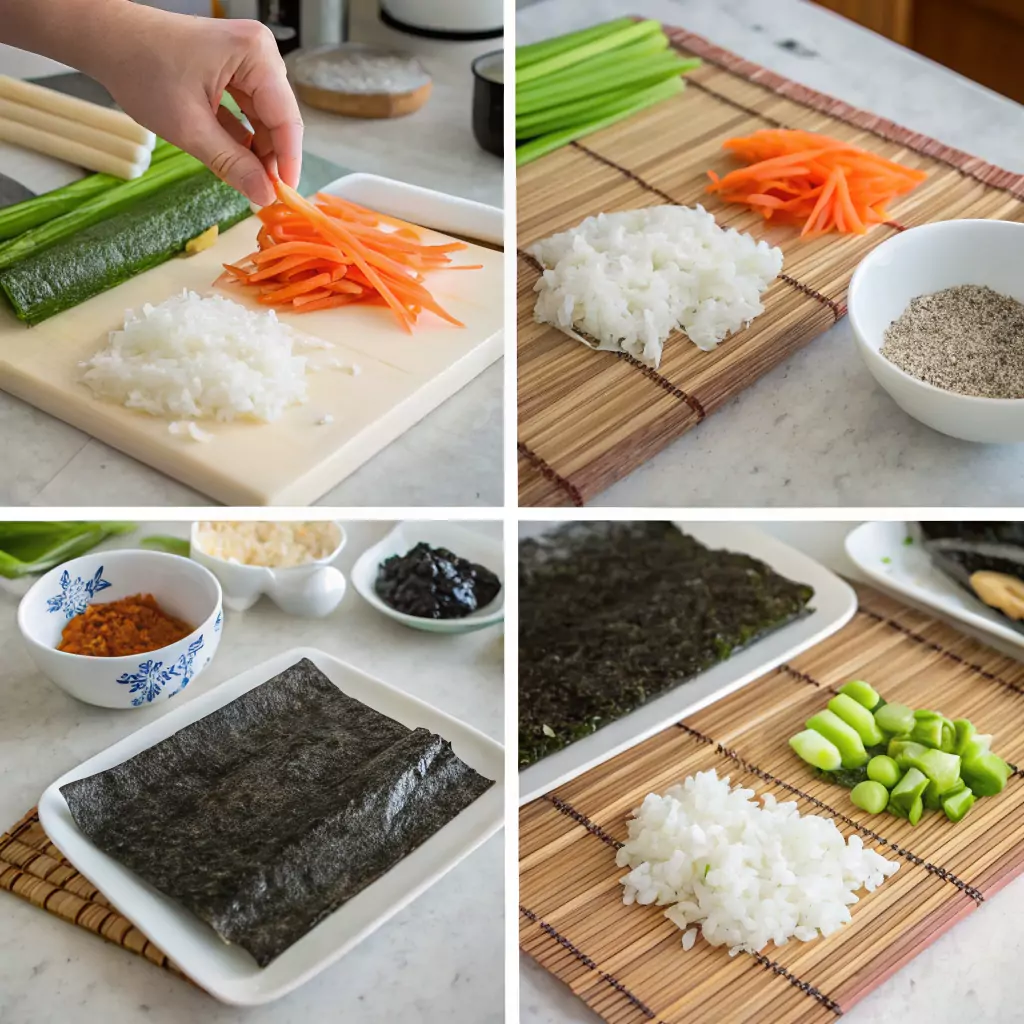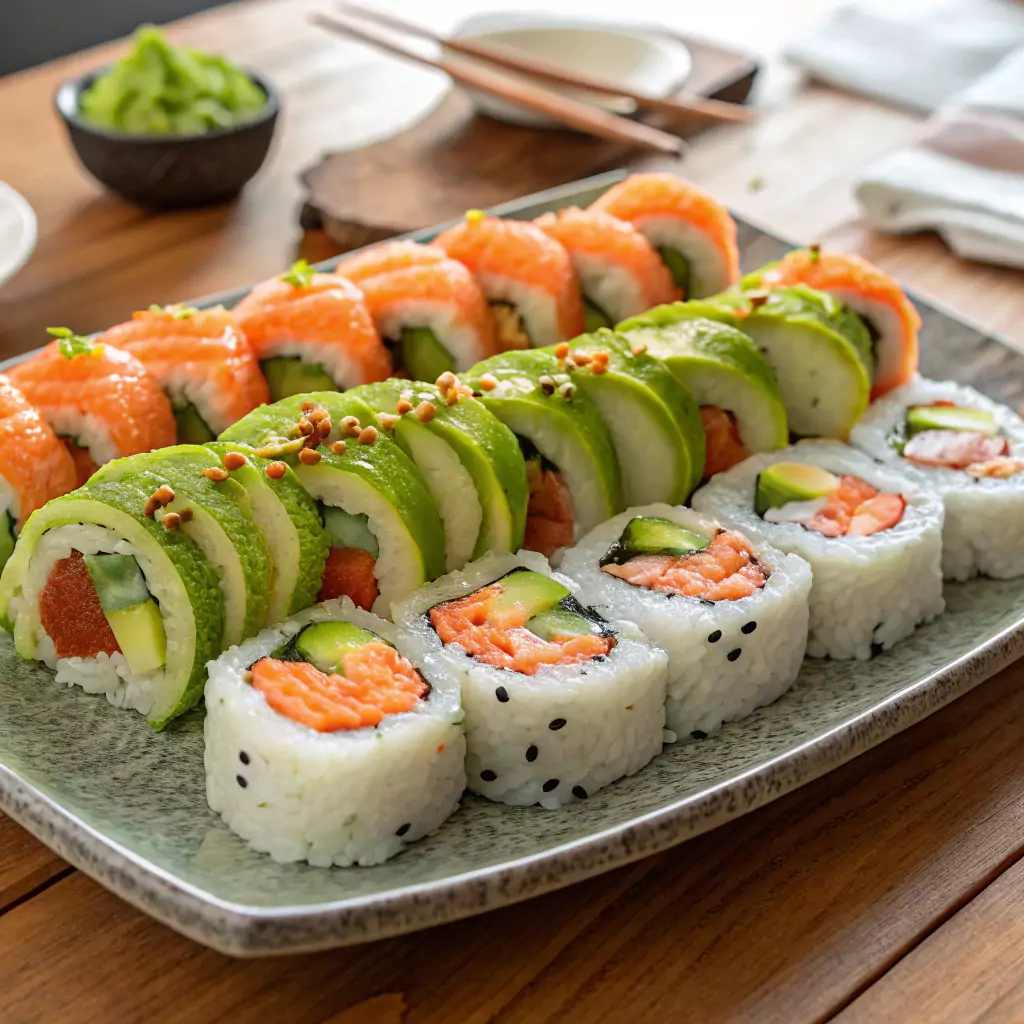Sushi is a beloved dish around the world, known for its fresh ingredients and unique flavors. However, for those who follow a gluten-free diet, enjoying sushi can sometimes be tricky. This article explores the world of gluten-free sushi, from its ingredients and types of rolls to making it at home. We’ll also discuss where to find it and answer some frequently asked questions to help you navigate this delicious cuisine safely. Let’s dive in!
Introduction to Gluten-Free Sushi
What is Gluten-Free Sushi?
Gluten-free sushi refers to sushi made without any ingredients that contain gluten, a protein found in wheat, barley, and rye. Traditional sushi often uses soy sauce, which usually contains gluten, making it essential for those with gluten sensitivities or celiac disease to choose their sushi carefully. Thankfully, with the rise in awareness about gluten intolerance, many restaurants now offer gluten-free options or alternatives.
Importance of Gluten-Free Diets
A gluten-free diet is crucial for individuals with celiac disease and gluten sensitivity. For these folks, consuming gluten can lead to severe health issues, including digestive problems, fatigue, and other symptoms. As awareness grows, more people are exploring gluten-free diets, whether for health reasons or personal choice. For more information on gluten sensitivity and its effects, visit the Celiac Disease Foundation.
Eating gluten-free doesn’t mean sacrificing flavor or variety. In fact, Sushi without gluten can be just as delightful and satisfying as traditional varieties. With the right ingredients and preparation, you can enjoy a delicious sushi experience without worrying about gluten. In this article, we’ll guide you through everything you need to know to enjoy gluten-free sushi safely and deliciously! For more information on gluten sensitivity and its effects, visit the Celiac Disease Foundation.
Now, let’s explore the ingredients that make up gluten-free sushi in the next part.
Ingredients in Gluten-Free Sushi
Traditional vs. Gluten-Free Ingredients
When it comes to making gluten-free sushi, understanding the difference between traditional and gluten-free ingredients is key. Traditional sushi often includes soy sauce, which typically contains wheat. This means it’s off-limits for anyone avoiding gluten. Additionally, some sushi rice might be mixed with vinegar that includes gluten.
However, the good news is there are plenty of alternatives. For instance, gluten-free soy sauce or tamari can be used in place of regular soy sauce. This allows you to enjoy the same savory flavor without the gluten.
Common Gluten-Free Sushi Ingredients
Here are some common ingredients you can find in gluten-free sushi:
- Rice: Sushi rice is naturally gluten-free. Just make sure to check that any added seasonings are also gluten-free.
- Seaweed: Nori is the seaweed used to wrap sushi and is gluten-free.
- Vegetables: Fresh veggies like cucumber, avocado, and carrots add crunch and flavor without introducing gluten.
- Fish: Fresh fish and seafood are inherently gluten-free. Just ensure they’re not marinated in any gluten-containing sauces.
- Gluten-Free Sauces: Look for gluten-free soy sauce or sauces made from rice vinegar.
By choosing the right ingredients, you can create a delicious gluten-free sushi experience. Whether you’re making it at home or ordering at a restaurant, knowing what’s safe to eat is crucial.
Types of Gluten-Free Sushi Rolls
Popular Gluten-Free Sushi Rolls
Now that you know what ingredients to use, let’s talk about the types of gluten-free sushi rolls you can enjoy. There are many delicious options available, and here are a few favorites:
- California Roll: Often made with crab (or imitation crab), avocado, and cucumber, the California roll can easily be made gluten-free by using gluten-free soy sauce.
- Rainbow Roll: This vibrant roll typically features various fish on top of a California roll base. Make sure to confirm that the sauces used are gluten-free.
- Cucumber Roll: A simple yet refreshing option, the cucumber roll has just rice and cucumber wrapped in nori. It’s naturally gluten-free and perfect for those wanting something light.
Creative Gluten-Free Sushi Roll Recipes
If you’re feeling adventurous, why not try making some unique gluten-free sushi rolls at home? Here are a couple of ideas to get you started:
- Spicy Tuna Roll: Use fresh tuna mixed with a gluten-free spicy mayo, rolled with cucumber and avocado for a kick.
- Veggie Tempura Roll: Instead of traditional tempura, use gluten-free batter to fry up veggies like sweet potato and zucchini. Roll them up with sushi rice and nori for a crunchy delight.
There are endless possibilities when it comes to gluten-free sushi. With a little creativity, you can mix and match ingredients to find your perfect roll. Whether you keep it classic or try something new, the options are delicious!
In the next part, we’ll dive into how to make gluten-free sushi at home.
How to Make Gluten-Free Sushi at Home

Essential Tools for Making Sushi
Creating sushi at home without gluten can be a fun and rewarding experience. To get started, you’ll need a few essential tools:
- Bamboo Sushi Mat: This is crucial for rolling your sushi tightly. It helps create a perfect roll every time.
- Sharp Knife: A good knife is necessary for slicing your rolls cleanly. This prevents squishing the ingredients.
- Rice Cooker or Pot: Cooking sushi rice properly is key. A rice cooker can make this easier, but a pot works just as well.
- Mixing Bowl: You’ll need this for seasoning your rice and mixing ingredients.
With these tools in hand, you’re ready to whip up some delicious gluten-free sushi!
Step-by-Step Guide to Making Gluten-Free Sushi
Here’s a simple recipe to get you started on making your own gluten-free sushi:
- Prepare the Sushi Rice: Rinse 1 cup of sushi rice under cold water until the water runs clear. Cook it in a rice cooker or pot with 1 ¼ cups of water. Once cooked, let it sit for about 10 minutes.
- Season the Rice: In a small bowl, mix 2 tablespoons of rice vinegar, 1 tablespoon of sugar, and a pinch of salt. Gently fold this mixture into the rice once it’s cooled slightly.
- Lay Out Your Ingredients: Gather your choice of fillings, such as fresh fish, avocado, and cucumber. You can also use gluten-free sauces like tamari for dipping.
- Assemble the Sushi: Place a sheet of nori on your bamboo mat, shiny side down. Spread a thin layer of sushi rice over the nori, leaving about an inch at the top. Add your fillings in a line across the center.
- Roll It Up: Using the bamboo mat, roll the sushi away from you, pressing gently but firmly. Use a bit of water to seal the edge of the nori.
- Slice and Serve: Use a sharp knife to slice the roll into bite-sized pieces. Serve with gluten-free soy sauce or your favorite dipping sauce.
Making gluten-free sushi at home not only allows you to control the ingredients but also sparks creativity in the kitchen. If you’re looking for more delicious recipes, check out our article on Sushi Bake Recipe.
Where to Find Gluten-Free Sushi
Restaurants Offering Gluten-Free Sushi
If you’re not in the mood to make sushi at home, don’t worry! Many restaurants now offer gluten-free sushi options. Here are some tips for finding them:
- Check Menus Online: Many restaurants list their gluten-free options on their websites. Look for dedicated gluten-free sections or notes on the menu.
- Ask the Staff: When dining out, don’t hesitate to ask your server about gluten-free choices. They can guide you on what’s safe to eat.
Tips for Ordering Gluten-Free Sushi
When ordering gluten-free sushi, keep these tips in mind:
- Specify Your Needs: Always mention your gluten sensitivity when ordering. This ensures the kitchen takes extra precautions.
- Choose Simple Rolls: Opt for rolls that use fresh ingredients without complicated sauces. Basic rolls like cucumber or avocado rolls are typically safe.
- Avoid Cross-Contamination: Ask if the restaurant uses separate utensils or cutting boards for gluten-free items to avoid cross-contamination.
Enjoying sushi that is free from gluten is possible with some research and clear communication.
Whether you choose to make it at home or dine out, there are plenty of delicious options available.
In the next part, we’ll discuss the nutritional benefits of gluten-free sushi.
Nutritional Benefits of Gluten-Free Sushi
Health Benefits of Sushi Ingredients
One of the great things about gluten-free sushi is that it can be very nutritious. Let’s take a closer look at some of the health benefits of typical sushi ingredients:
- Fish: Fresh fish, like salmon and tuna, are packed with omega-3 fatty acids. These healthy fats are great for heart health and brain function.
- Vegetables: Ingredients like avocado, cucumber, and carrots add fiber, vitamins, and minerals. This makes your sushi not just tasty, but also filling and nutritious.
- Seaweed: Nori, the seaweed used in sushi, is low in calories and contains essential nutrients like iodine and vitamins A and C. Learn more about the benefits of these essential fats in our article on omega-3 fatty acids.
Comparing Gluten-Free Sushi with Traditional Sushi
When comparing gluten-free sushi to its traditional counterpart, there are a few key points to consider:
- Lower in Calories: Since gluten-free sushi often avoids heavy sauces and fried ingredients, it can be lower in calories.
- Digestive Friendly: For those with gluten sensitivities, choosing gluten-free options can lead to better digestion and overall well-being.
- Variety of Flavors: With the right ingredients, gluten-free sushi can be just as flavorful and satisfying as regular sushi.
In summary, gluten-free sushi not only tastes great but also offers numerous health benefits. Eating it can be a delicious way to boost your nutrient intake!
FAQs about Gluten-Free Sushi
Is sushi gluten safe?
When considering gluten-free sushi, it’s essential to know that not all sushi is gluten safe. Traditional soy sauce typically contains gluten, which can make some sushi unsafe for those with gluten sensitivities. However, many restaurants offer gluten-free soy sauce or tamari as an alternative. Always check with the restaurant or read labels carefully when making sushi at home.
Are there gluten-free sushi rolls?
Yes, there are plenty of gluten-free sushi rolls! Many rolls can be made gluten-free by using fresh ingredients and gluten-free sauces. Popular options include cucumber rolls, avocado rolls, and those made with fish and vegetables. Just be sure to ask about the sauces used and confirm they are gluten-free.
How to identify gluten in sushi ingredients?
To identify gluten in sushi ingredients, always check labels and ingredient lists. Look for any mention of wheat, barley, or rye. When dining out, it’s best to ask the staff about specific ingredients and how they’re prepared to avoid any gluten contamination.
Can I make gluten-free sushi without rice?
Absolutely! You can make gluten-free sushi without traditional rice by using alternatives like cauliflower rice or quinoa. Both options offer a different texture and flavor while still being delicious. Just season them similarly to sushi rice, and you’re good to go!
These FAQs should help clarify some common questions about gluten-free sushi. With the right knowledge, you can enjoy this delightful dish safely and deliciously!
In the next part, we’ll wrap up our discussion on gluten-free sushi with a conclusion.
Conclusion
Recap of Gluten-Free Sushi Benefits
In conclusion, gluten-free sushi offers a delicious and healthy dining option for those with gluten sensitivities or celiac disease. By understanding the ingredients and preparation methods, you can enjoy this delightful cuisine without worry. From the fresh fish and crisp vegetables to the savory gluten-free sauces, there’s so much to love about gluten-free sushi.
Encouragement to Try Gluten-Free Sushi
Whether you decide to make it at home or find a local restaurant that offers gluten-free options, the experience can be both fun and rewarding. Don’t hesitate to experiment with different fillings and flavors to create your perfect roll. Remember, eating gluten-free doesn’t mean sacrificing taste or variety. So, go ahead and dive into the world of gluten-free sushi—you might just discover a new favorite dish!
Enjoy your culinary adventure, and happy sushi rolling!
Additional Resources
For those looking to explore more delicious recipes, don’t forget to check out our article on Sushi Bake Recipe. It’s a fantastic way to enjoy sushi flavors in a new format, perfect for gatherings or family meals. Explore and enjoy!

